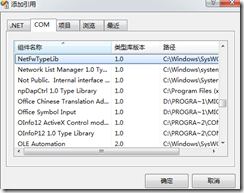很多时候,我们的程序是通过网络通信(如TCP或者UDP协议+端口),而将制作好的程序安装包给客户用时,发现会出现不能通信的现象(或者在这台电脑是可以的,却在另一台不可以),原因是防火墙阻止了,需要添加防火墙例外。现在将代码记录下来,方便以后备用。
在Visual studio 项目引用右键里面添加引用,选中COM然后找到NetFwTypeLib,确认,然后新建类FireWallHelp.cs添加
using NetFwTypeLib;
代码如下:
1 using System; 2 using System.Collections.Generic; 3 using System.Text; 4 using NetFwTypeLib; 5 6 namespace FireWallTest 7 { 8 public class FireWallHelp 9 { 10 /// <summary> 11 /// 添加防火墙例外端口 12 /// </summary> 13 /// <param name="name">名称</param> 14 /// <param name="port">端口</param> 15 /// <param name="protocol">协议(TCP、UDP)</param> 16 public static void NetFwAddPorts(string name, int port, string protocol) 17 { 18 //创建firewall管理类的实例 19 INetFwMgr netFwMgr = (INetFwMgr)Activator.CreateInstance(Type.GetTypeFromProgID("HNetCfg.FwMgr")); 20 21 INetFwOpenPort objPort = (INetFwOpenPort)Activator.CreateInstance( 22 Type.GetTypeFromProgID("HNetCfg.FwOpenPort")); 23 24 objPort.Name = name; 25 objPort.Port = port; 26 if (protocol.ToUpper() == "TCP") 27 { 28 objPort.Protocol = NET_FW_IP_PROTOCOL_.NET_FW_IP_PROTOCOL_TCP; 29 } 30 else 31 { 32 objPort.Protocol = NET_FW_IP_PROTOCOL_.NET_FW_IP_PROTOCOL_UDP; 33 } 34 objPort.Scope = NET_FW_SCOPE_.NET_FW_SCOPE_ALL; 35 objPort.Enabled = true; 36 37 bool exist = false; 38 //加入到防火墙的管理策略 39 foreach (INetFwOpenPort mPort in netFwMgr.LocalPolicy.CurrentProfile.GloballyOpenPorts) 40 { 41 42 if (objPort == mPort) 43 { 44 exist = true; 45 break; 46 } 47 } 48 if (exist) 49 { 50 System.Windows.Forms.MessageBox.Show("exist"); 51 } 52 if (!exist) netFwMgr.LocalPolicy.CurrentProfile.GloballyOpenPorts.Add(objPort); 53 } 54 /// <summary> 55 /// 将应用程序添加到防火墙例外 56 /// </summary> 57 /// <param name="name">应用程序名称</param> 58 /// <param name="executablePath">应用程序可执行文件全路径</param> 59 public static void NetFwAddApps(string name, string executablePath) 60 { 61 //创建firewall管理类的实例 62 INetFwMgr netFwMgr = (INetFwMgr)Activator.CreateInstance(Type.GetTypeFromProgID("HNetCfg.FwMgr")); 63 64 INetFwAuthorizedApplication app = (INetFwAuthorizedApplication)Activator.CreateInstance( 65 Type.GetTypeFromProgID("HNetCfg.FwAuthorizedApplication")); 66 67 //在例外列表里,程序显示的名称 68 app.Name = name; 69 70 //程序的路径及文件名 71 app.ProcessImageFileName = executablePath; 72 73 //是否启用该规则 74 app.Enabled = true; 75 76 //加入到防火墙的管理策略 77 netFwMgr.LocalPolicy.CurrentProfile.AuthorizedApplications.Add(app); 78 79 bool exist = false; 80 //加入到防火墙的管理策略 81 foreach (INetFwAuthorizedApplication mApp in netFwMgr.LocalPolicy.CurrentProfile.AuthorizedApplications) 82 { 83 if (app == mApp) 84 { 85 exist = true; 86 break; 87 } 88 } 89 if (!exist) netFwMgr.LocalPolicy.CurrentProfile.AuthorizedApplications.Add(app); 90 } 91 /// <summary> 92 /// 删除防火墙例外端口 93 /// </summary> 94 /// <param name="port">端口</param> 95 /// <param name="protocol">协议(TCP、UDP)</param> 96 public static void NetFwDelApps(int port, string protocol) 97 { 98 INetFwMgr netFwMgr = (INetFwMgr)Activator.CreateInstance(Type.GetTypeFromProgID("HNetCfg.FwMgr")); 99 if (protocol == "TCP") 100 { 101 netFwMgr.LocalPolicy.CurrentProfile.GloballyOpenPorts.Remove(port, NET_FW_IP_PROTOCOL_.NET_FW_IP_PROTOCOL_TCP); 102 } 103 else 104 { 105 netFwMgr.LocalPolicy.CurrentProfile.GloballyOpenPorts.Remove(port, NET_FW_IP_PROTOCOL_.NET_FW_IP_PROTOCOL_UDP); 106 } 107 } 108 /// <summary> 109 /// 删除防火墙例外中应用程序 110 /// </summary> 111 /// <param name="executablePath">程序的绝对路径</param> 112 public static void NetFwDelApps(string executablePath) 113 { 114 INetFwMgr netFwMgr = (INetFwMgr)Activator.CreateInstance(Type.GetTypeFromProgID("HNetCfg.FwMgr")); 115 116 netFwMgr.LocalPolicy.CurrentProfile.AuthorizedApplications.Remove(executablePath); 117 118 } 119 } 120 }
